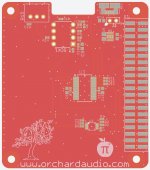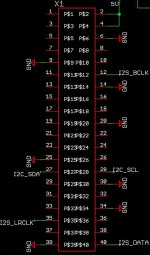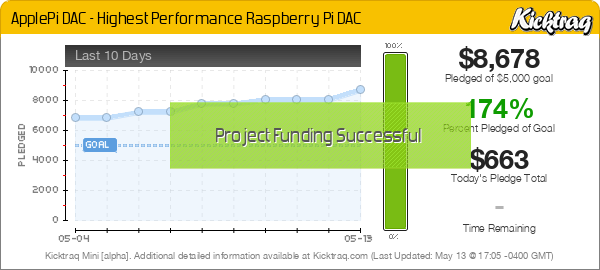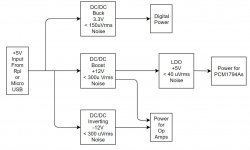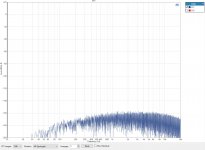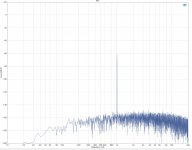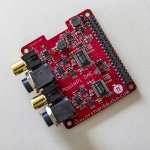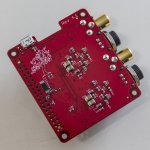ApplePi Volume-Clocker
The ApplePi Volume-Clocker allows you add hardware volume control to any RapsberryPi I2S DAC.
Volume is controlled by a potentiometer R15. Volume is adjustable from 0 dB to -127.5dB, in 256 steps.
In addition to HW volume control this board will also remove jitter from the RapsberryPi's I2S signals improving audio quality.
It can be powered externally though it's own micro USB (X6) connector or from the Raspberry Pi. The ApplePi Volume-Clocker cannot back power the Raspberry Pi.
Specs:
The ApplePi Volume-Clocker can be added to any reward level for $79 USD, except for the touchscreen one. It can also be purchased separately for $79.
ApplePi DAC - Highest Performance Raspberry Pi DAC by Leonid (Leo) Ayzenshtat —Kickstarter
The ApplePi Volume-Clocker allows you add hardware volume control to any RapsberryPi I2S DAC.
Volume is controlled by a potentiometer R15. Volume is adjustable from 0 dB to -127.5dB, in 256 steps.
In addition to HW volume control this board will also remove jitter from the RapsberryPi's I2S signals improving audio quality.
It can be powered externally though it's own micro USB (X6) connector or from the Raspberry Pi. The ApplePi Volume-Clocker cannot back power the Raspberry Pi.
Specs:
- Dynamic Range: 144 dB (–60-dbFS Input, 20 Hz to fS/2, A-Weighted)
- THD+N: –140 dB (0-dbFS Input, BW = 20 Hz to fS/2)
- Supported Resolutions: 24-bit, 20-bit, 18-bit, and 16-bit
- Supports sampling rates up to 212 kHz
- No drivers required.
The ApplePi Volume-Clocker can be added to any reward level for $79 USD, except for the touchscreen one. It can also be purchased separately for $79.
ApplePi DAC - Highest Performance Raspberry Pi DAC by Leonid (Leo) Ayzenshtat —Kickstarter
Attachments
Hey since the kickstarter is a big hit(congrats btw), how about throwing us diy:ers a bone? 
Your DAC shows great promise IMHO, but a lot of us "need" utility and connectivity, there's almost as many setups out there as there are diy:ers. I personally would like a version with spdif input(as i have a bunch of sources that i'd like to sound as good as possible) and it could be interesting to try the PCM1794 is NOS mode or in general play around with filtering options. And paired with a proper PSU such as Salas Ref-D maybe?
I remember fondly reading about this dac back in the day.
A DIY dream version wouldn't have to be so compact, maybe a version with mixed SMD and through-hole, where the dacs and receiver and other bits that are tricky to solder would be sold pre-soldered with the board, and through-hole for the rest?
Your DAC shows great promise IMHO, but a lot of us "need" utility and connectivity, there's almost as many setups out there as there are diy:ers. I personally would like a version with spdif input(as i have a bunch of sources that i'd like to sound as good as possible) and it could be interesting to try the PCM1794 is NOS mode or in general play around with filtering options. And paired with a proper PSU such as Salas Ref-D maybe?
I remember fondly reading about this dac back in the day.
A DIY dream version wouldn't have to be so compact, maybe a version with mixed SMD and through-hole, where the dacs and receiver and other bits that are tricky to solder would be sold pre-soldered with the board, and through-hole for the rest?
The ApplePi DAC went on a tour around the country. Here is what people who have tried it, have to say:
Wayne - Littleton, CO
"This is a very well engineered and built DAC. I again suggest folks sign up for the tour and listen yourself." and "I spent a good week listening to it and came away extremely impressed with what Leo has done with this DAC hat."
Alan - Harrisburg, OR
"I have had the Apple Pie for a while and I must say I am really impressed." and "Any way this is a dammed fine budget setup that punches way above it's weight."
Sharschchandra - Austin, TX
"The build quality is top notch and I really like the layout." and "The unit sound great out of box, very organic, almost neutral and full bodied (compared to ES9038PRO based DACs). The vocals were amazing especially on the JBL 4312B monitors."
Jerry - Camarillo, CA
"This is one sweet little Dac, Leo. I actually left work early today just to spend more time getting to listen." and "You have one helluva nice piece here; I appreciate the gracious demo."
The tour continues to this day, and will continue beyond Kickstarter. If you would like to sign up, go here:
Introducing ApplePi DAC -- Highest Performance Raspberry Pi DAC
Wayne - Littleton, CO
"This is a very well engineered and built DAC. I again suggest folks sign up for the tour and listen yourself." and "I spent a good week listening to it and came away extremely impressed with what Leo has done with this DAC hat."
Alan - Harrisburg, OR
"I have had the Apple Pie for a while and I must say I am really impressed." and "Any way this is a dammed fine budget setup that punches way above it's weight."
Sharschchandra - Austin, TX
"The build quality is top notch and I really like the layout." and "The unit sound great out of box, very organic, almost neutral and full bodied (compared to ES9038PRO based DACs). The vocals were amazing especially on the JBL 4312B monitors."
Jerry - Camarillo, CA
"This is one sweet little Dac, Leo. I actually left work early today just to spend more time getting to listen." and "You have one helluva nice piece here; I appreciate the gracious demo."
The tour continues to this day, and will continue beyond Kickstarter. If you would like to sign up, go here:
Introducing ApplePi DAC -- Highest Performance Raspberry Pi DAC
"Organic, almost neutral and full bodied"
Sounds like my cup of tea. I better make myself an AudioCircle account!
This would be a good time to sign up for the tour, because the unit is getting shipped to the last person this week.
+1 on the sentiment from Kris0603 a couple of posts above. How many DAC HATs do we need on the market? Sure you seem to have the best specs. S/N outta this world (although I am skeptical when I see such stratospheric numbers). But without some kind of input the utility of all of these HATs are limited to playback only, meaning they cannot be used as a DSP device with processing done within the Pi itself and the HAT as I/O.
Currently I can purchase a good quality 24/96 or 24/192 USB pro audio recording interface with a great ADC and at least stereo balanced outputs for less than your asking price of $250. Also has very good specs, though not quite as high as what you have shown for your produce. Still, I don't see the upside of the HAT when compared to a platform that includes input.
Build a quality HAT with both input (even if only digital e.g. spdif) and output, and you've got something there.
Currently I can purchase a good quality 24/96 or 24/192 USB pro audio recording interface with a great ADC and at least stereo balanced outputs for less than your asking price of $250. Also has very good specs, though not quite as high as what you have shown for your produce. Still, I don't see the upside of the HAT when compared to a platform that includes input.
Build a quality HAT with both input (even if only digital e.g. spdif) and output, and you've got something there.
Last edited:
+1 on the sentiment from Kris0603 a couple of posts above. How many DAC HATs do we need on the market? Sure you seem to have the best specs. S/N outta this world (although I am skeptical when I see such stratospheric numbers). But without some kind of input the utility of all of these HATs are limited to playback only, meaning they cannot be used as a DSP device with processing done within the Pi itself and the HAT as I/O.
Currently I can purchase a good quality 24/96 or 24/192 USB pro audio recording interface with a great ADC and at least stereo balanced outputs for less than your asking price of $250. Also has very good specs, though not quite as high as what you have shown for your produce. Still, I don't see the upside of the HAT when compared to a platform that includes input.
Build a quality HAT with both input (even if only digital e.g. spdif) and output, and you've got something there.
You can use the ApplePi DAC without a Raspberry Pi and hook it up to either a USB to I2S converter like this one.
You can also hook it up to an SPDIF to I2S converter like this one.
There are many different option for SPDIF to I2S and USB to I2S.
Here is the pin out of the ApplePi DAC's connector. All you need is 5V and then the I2S signals. The I2C lines are not needed if you are not using with Raspberry Pi.
Attachments
Orchard, i really dig your enthusiasm about your product, and as i've said before your product appears good, but kindly entertain the notion that 98.5% of the people in this particular forum know the difference about I2S and SPDIF, for instance.
Please don't take this the wrong way, i believe you are well within your forum rights to say whatever and as often as you'd like, still i can't help but think you might get more positive attention(and by extension, perhaps more interest in your product in the future) from the community as a whole if you engaged us more as a designer and maker than as an (understandably so) excited salesperson.
Your PSU btw looks nice, did you ever consider a bigger board with separate regs per dac? Can you give us any insight into your design process thinking for the PSU?
Please don't take this the wrong way, i believe you are well within your forum rights to say whatever and as often as you'd like, still i can't help but think you might get more positive attention(and by extension, perhaps more interest in your product in the future) from the community as a whole if you engaged us more as a designer and maker than as an (understandably so) excited salesperson.
Your PSU btw looks nice, did you ever consider a bigger board with separate regs per dac? Can you give us any insight into your design process thinking for the PSU?
Last edited:
Orchard, i really dig your enthusiasm about your product, and as i've said before your product appears good, but kindly entertain the notion that 98.5% of the people in this particular forum know the difference about I2S and SPDIF, for instance.
Please don't take this the wrong way, i believe you are well within your forum rights to say whatever and as often as you'd like, still i can't help but think you might get more positive attention(and by extension, perhaps more interest in your product in the future) from the community as a whole if you engaged us more as a designer and maker than as an (understandably so) excited salesperson.
Your PSU btw looks nice, did you ever consider a bigger board with separate regs per dac? Can you give us any insight into your design process thinking for the PSU?
See attachment for the power supply topology on the ApplePi DAC.
As you can see all of the power supplies generate little noise whether they are digital or analog. Couple that with the PSRR of the parts and noise become extremely low. That is how the DAC is able to achieve such good SNR. All power supply noise figures are measured band limited 20Hz to 20kHz.
The OPA1612 opamps have a PSRR of >70dB below 20kHz.
If proper decoupling techniques are used there is really no need use separate power supplies for each of the DAC chips. This board already achieves a cross talk of > 135dB.
In order to stay within the Raspberry Pi hat specification the board has to be the size that it is.
The second image shows FFT (A-Weighed) of the output of the DAC with 0 FS input.
The third image shows FFT (A-Weighed) of the output of the DAC with -60 dBFS input.
What else would you like to know?
Attachments
Last edited:
Comparing the 'grass' between the two plots there does look to be significant modulation of the noise floor by the presence of the -60dB signal. Would that be attributable to the DAC chip or some other factor do you think?
It is an attribute of the PCM1794A, due to the way that it handles 0 input (silence).
Last edited:
Hi orchardaudio,
Cool project, congratulations!
Please notice, your signature's link is not correct... Somebody could forget to browse .com instead of .con.
Best regards
Stammheim
Thanks. Will fix signature.
The ApplePi Volume-Clocker is now available for purchase:
ApplePi Volume-Clocker - Hardware Volume Control and Reclocking for Raspberry Pi | eBay
The ApplePi DAC will be going up for sale shortly.
ApplePi Volume-Clocker - Hardware Volume Control and Reclocking for Raspberry Pi | eBay
The ApplePi DAC will be going up for sale shortly.
Both the ApplePi DAC and Volume-Clocker are now available for purchase.
You can buy from my ebay store here:
ApplePi DAC -- ApplePi DAC - Ultra High Performance Raspberry Pi DAC | eBay
ApplePi Volume-Clocker -- ApplePi Volume-Clocker - Hardware Volume Control and Reclocking for Raspberry Pi | eBay
You can also send me an email to leo@orchardaudio.com to buy direct and save 5%.
You can buy from my ebay store here:
ApplePi DAC -- ApplePi DAC - Ultra High Performance Raspberry Pi DAC | eBay
ApplePi Volume-Clocker -- ApplePi Volume-Clocker - Hardware Volume Control and Reclocking for Raspberry Pi | eBay
You can also send me an email to leo@orchardaudio.com to buy direct and save 5%.
- Status
- This old topic is closed. If you want to reopen this topic, contact a moderator using the "Report Post" button.
- Home
- Vendor's Bazaar
- ApplePi DAC -- Highest Performance Raspberry Pi DAC
